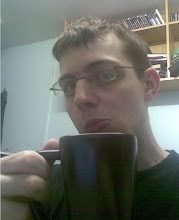Upon my return to Newport, I quickly set to work finishing off the new texture for the enemy model, using the grain filter at varying settings to simulate the mottled look of the fabrics on the character, as well as painting highlights onto the visor and plastic components:
A Comparison of the “materialess” texture to the one with materials added. The most visible applications of materials on the green segments, the visor, and the plastic armour segments.
Admittedly, this week onward saw a reduction in time I devoted to the project. Most of the content that had or could be prepared by the designers had been completed, and what work was left was programming tasks. Also, my time on the project and fixing the problems I had encountered had been at the cost of other commitments that needed to be caught up on. I regret not being able to help our programmers out more, but the programming they are working on is beyond my scope of understanding.

I made the final few animations for the enemy (including a “working” animation Lloyd requested for when the enemies were working at the consoles on the airships). It was during this time however, that I discovered some fundamental flaws in the designs (namely an error setting up controls on one arm, and an inability to twist the hands of the character, which meant I could not turn the fingers to be properly facing the console). Also, the texture problem that had occurred before had appeared again on the animation files, and I did not know how to fix the problem without inadvertently deleting the Presenting the problems to Hannah, she explained that time had sadly run out really to work on anything else, and to now cut our losses and polish up what we could, though I was relieved to hear that the way the animations work in Torque (with a .dts model file and several .dsq animation files) means that the deforming animations on the animations will be ignored, as they will instead use the texture on the static base model, which had already been fixed.
I also finally managed to fix the problem that was preventing the enemy from exporting correctly by restarting the adding of the collision meshes, using Hannah’s Chrono model as a reference. In engine the model was fine, though the Torque engine I was using for my tests in the university lab was crashing when the model’s collision mesh made contact with anything. This however was also happening with Hannah’s Chrono model, which I knew from our presentations was working fine in our build, so I decided that this error was likely something to do with that particular install of Torque, likely to do with our models not being optimised for the pre-made game example (one of the examples that come packaged with Torque) that I was inserting them into.
My final piece of work was in week 14, which saw me texture Harry’s fortress model; a relatively quick procedure (especially thanks to a “difference cloud” filter that I found created a nice looking mottled metal surface effect) and I got it ready for export by the weeks end:
Unfortunately, some sort of error in the fortress model meant that attempts to bring the model into Engine failed (it would appear as an empty box, much like the enemy model did before) and so could not be put into engine. There was no time to work out what had happened, and an attempt to fix it in the same way i did the enemy model failed, forcing me to abandon the model and leave it as an unused asset.
This concluded my work for the “Save The Fortress” project. It was a pity to have to leave the project unfinished, especially as I had admittedly become quite attached to the concepts and ideas behind it, but time had caught up with us and forced our hand. I have had a lovely time working alongside the team, who had proven themselves as a capable workers and good companions throughout. I did notice several majors problems in my work practices and mild ones practices of the group mechanics that I could make note of for future projects, which had been a primary point of this module in the first place; a simulation of a real design house environment to prepare students for the industry. I certainly feel it has achieved this, and I am already confident that several of the skills and tips I have learnt on this project will help me in my upcoming third year assignment.
